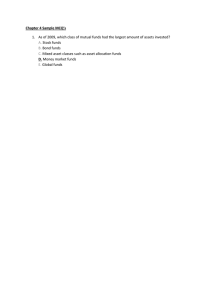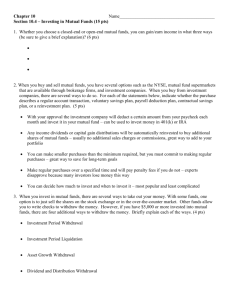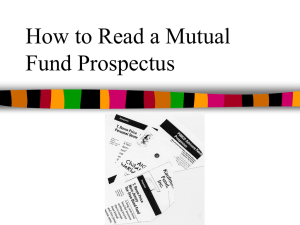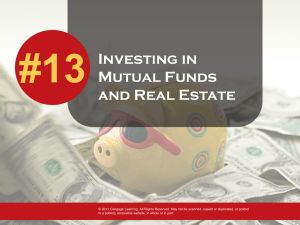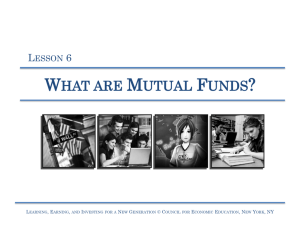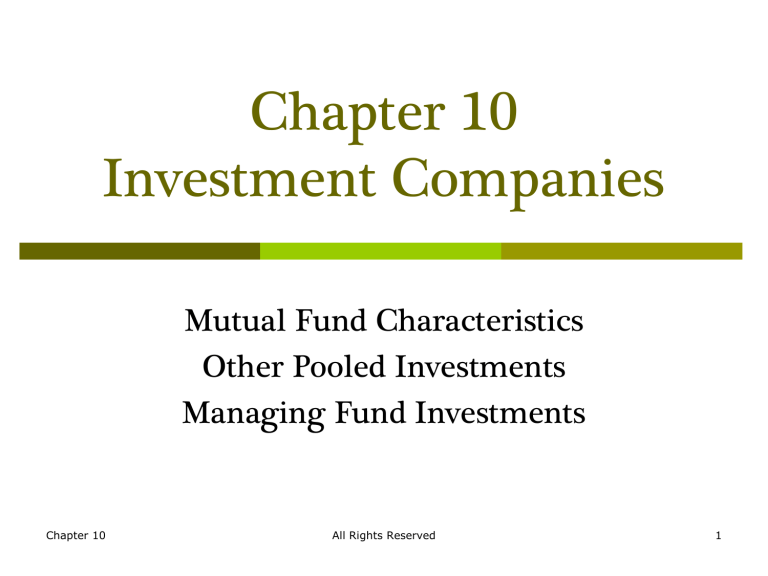
Chapter 10
Investment Companies
Mutual Fund Characteristics
Other Pooled Investments
Managing Fund Investments
Chapter 10
All Rights Reserved
1
Student Learning Objectives
What are mutual funds?
Open-end vs. closed-end funds
UIT, REIT, RELP, REMIC
Selecting a mutual fund
Managing mutual fund investments
Chapter 10
All Rights Reserved
2
Forming a Mutual Fund
Investment company forms the fund and advertises its
investment objectives, fees, and fund manager.
Interested parties buy shares (of beneficial interest) at a
preset price (NAV).
Fund manager then invests the proceeds of the share sale
in a variety of stocks.
Thereafter, NAV set by stock prices
Value of mutual fund assets minus liabilities divided by number
of outstanding shares
Regulatory requirements for Investment Companies
Chapter 10
Must distribute
All Rights Reserved
3
Types of Mutual Funds
Open-end
Investment Company stands ready to buy and sell
Price based on NAV (sales charge possible)
Active or Passive management
May have multiple classes (fee schedules)
Closed-end
One time issuance of shares
Shares publicly traded
Tend to trade at a discount to NAV
Chapter 10
All Rights Reserved
4
Types of Mutual Funds
Stock Funds (common, preferred)
Bond Funds (short-, intermediate- or long-term)
Balanced Funds (stocks and bonds)
Taxable vs. Tax “free”
Index Funds (SP500, Nasdaq, Russell, Wilshire )
Sector Funds (Energy, Utility, Transportation)
Global Funds (Europe, Far East, Emerging)
Exchange Traded Funds (ETF)
Chapter 10
All Rights Reserved
5
Types of Mutual Funds
Asset Allocation
Socially Responsible
Money Market
REITs and RELPs
Unit investment trusts
Unmanaged
Self-liquidating
Largely consist of short-term debt securities
Hedge funds
Real estate applications: commercial, residential
Typically organized as offshore limited partnerships for qualified
investors
Maximum investment flexibility
Variable annuities
Chapter 10
Mutual fund type of instrument originating at insurance companies
All Rights Reserved
6
Investm ent Com pany Assets
Year-End 1995 - 2008
www.icifactbook.org
14000
12000
Open-End
ETF
$ (Billions)
10000
Closed-end
UIT
8000
6000
4000
2000
Chapter 10
All Rights Reserved
2008
2007
2006
2005
2004
2003
2002
2001
2000
1999
1998
1997
1996
1995
0
7
Fund Operating Details
Distribution Requirements
IRS (Subchapter M) requires funds to distribute no less than 90%
of interest and dividends received.
The same applies to “net” realized capital gains
Load Charges
Most funds are no-load
Sales charges may vary according to fund
Realized = result of buying and selling
Front-end vs. Back-end (tied to holding period or class)
Sales charges tend to discourage timing or frequent trading
May also involve break-points
Management (Advisory) Fees, 12b-1 Fees
Chapter 10
All Rights Reserved
8
Fund Operating Details
Distribution (sales)
Direct marketing (Vanguard, Fidelity, etc., websites)
Sales Force
Broker-Dealers
Financial Planners
Retirement fund jobbers (Planco Div of HIG)
Prospectus Requirements
Chapter 10
Investor purchase must be followed by receipt of fund
prospectus
Annual reports required, may receive quarterly reports
All Rights Reserved
9
Pros & Cons of Mutual Funds
Pros
Professional portfolio management
Diversification (risk reduction)
Convenience
Record keeping
Other factors
Chapter 10
Examples: liquidity, minimal investment requirements,
regulation
All Rights Reserved
10
Pros & Cons of Mutual Funds
Cons
Chapter 10
Management fees, expenses, and loads for load funds
reduce their returns.
Large investors, such as mutual funds, sometimes
adversely affect the market when they trade.
Institutions usually restrict their analysis to a small
percentage of traded stocks (i.e., the larger ones).
All Rights Reserved
11
Net Asset Value (NAV)
Per-share market value of mutual fund’s portfolio:
NAV = (total assets – total liabilities)
number of shares outstanding
Forms of Return
Price Appreciation: Increase in NAV
Dividends and Interest: Pass-through of dividends and interest
received on portfolio
Chapter 10
Regular dividend
Capital Gain Distribution: Payment of net capital gain recognized
by fund during year
Reinvestment Strategies: auto-reinvest, cash distribution
All Rights Reserved
12
Load Charges
Contingent deferred sales charge (CDSC) is a back-end
load that declines over time
Back-end loads discourage trading by investors
Front-end loads compensate the broker
No-load funds tend to be most popular
Share Class Structure
Chapter 10
Class A: Usually large front-end load, and minimal or no 12b-1
fee . Best if plan long holding period
Class B: Back-end load and 12b-1 fees, usually convertible to
Class A after load waived
Class C: Minimal or no front-end or back-end load, but
substantial 12b-1 fee. Best if plan short holding period
All Rights Reserved
13
Operating Expenses
Management or advisory fees and other
operating expenses
12b -1 fees cover distribution costs
Paid out of investment income as percent of
NAV
Compare loads and operating expenses for
varying time periods in evaluating funds
No evidence that higher fees or load charges
bring superior performance
Chapter 10
All Rights Reserved
14
Performance and taxes
Mutual funds are not taxed directly on income or
capital gains as these are passed on to the
shareholders
Returns can be broken down into distributions
and change in NAV
Portfolio turnover relates to higher capital gains
distributions and unrealized capital gains
Don’t purchase just before a distribution
Chapter 10
All Rights Reserved
15
Managing Fund Investments
Passive versus active
Personal objectives may change over time
Dollar-cost averaging results from investing
equal dollar amounts at regular intervals
Can be beneficial when prices fluctuate, but…
if prices continually rise, buying more earlier is better
Rebalancing Investment Portfolio
Chapter 10
Adjusting allocations to desired risk-return target
All Rights Reserved
16
Regulations and Taxation
The SEC regulates U. S. fund operations through
Mutual Fund Act of 1940.
State approval is also required to sell shares
Most funds are taxed as regulated investment
companies:
Chapter 10
All investment income must be distributed to
shareholders each year
All tax liability falls to individual shareholders
All Rights Reserved
17
Mutual Fund Services
Automatic reinvestment of distributions
Automatic investment plans
Check writing (money market funds)
Exchange privileges within fund families
Periodic statements
Chapter 10
All Rights Reserved
18
Why Mutual Funds?
Positives
Professional management
Diversification
Convenience
Marketability
Ease of exchange
Negatives
Chapter 10
Most funds under perform the indexes
Fund performance depends on fund manager and
market conditions
All Rights Reserved
19
Special Issues in Closed-End Funds
No prospectus to traders
May have tax liabilities (liquidation)
May be leveraged (additional risk)
May have liquidity problems (thinly traded)
Possibility of conversion to open-end
Different distribution structures (managed)
Tends to trade at less than NAV
Chapter 10
All Rights Reserved
20
Real Estate Investment Companies
Real Estate Investment Trust (REIT)
Min of 75% invested in RE
Required to pay out 90% of income
Equity REITs: income producing
Mortgage REITs: making loans
Hybrids
Real estate Limited Partnerships (RELP)
Chapter 10
More complex tax rules
May have a liquidation time set
May involve sales charges
Many sell at discounts
All Rights Reserved
21
Real Estate Investment Companies
RE Mortgage Investment Conduits (REMIC)
Chapter 10
Created by breaking up interest and principal streams
Different maturity packs to match investor needs
Bear Stearns was major player in this market (> JPM)
All Rights Reserved
22
Unit Investment Trust
Debt
Equity
Funds invested in bonds
Bond UIT have fixed lives.
Purpose: provide known income stream
Funds invested in Equities
All have termination date: liquidation > distribution
Pros and Cons
Chapter 10
Negligible fees, tax efficient, convenient
Sales charges, lack of marketability
All Rights Reserved
23
Exchange Traded Funds
Alternative to Mutual Funds
Chapter 10
No minimum holding period
Can mimic indexes, sector, countries, etc.
Many are very liquid – 51 traded more than 500,000
shares (April, 2008), another 60 at least 100,000 shares
Even more are thinly traded: 259 ETF had daily
volumes under 100,000 shares (April, 2008)
Marginable
Able to sell short
All Rights Reserved
24
Other Investment Vehicles
Hedge Funds
Multiple fronts
Derivatives: options and futures
Stocks and bonds
International
Costly and Risky
Performance suspect – backfilling
Losses can be significant – e.g. LTCM
Variable Annuities
Chapter 10
Industry is still evolving – trying to increase returns
All Rights Reserved
25
Other Investment Vehicles
Pooled Portfolios
Chapter 10
Operating or holding companies: Some operating or
holding companies hold such large portfolios that
their performances are more closely related to their
security holdings than to their operations.
Partnerships: Some investment companies choose the
partnership form, often a limited partnership, because
of its greater flexibility and/or tax advantages.
Blind pools: Investors bankroll enterprises whose
purposes will later be revealed; these pools are
sometimes involved in takeover financing.
All Rights Reserved
26
Selecting and Evaluating Funds
Evaluate Historic Performance
Against a benchmark like the S&P 500 over time
Morningstar or Weisenberger publications
Assess Future Performance
Chapter 10
Some believe that past performance is a poor
predictor since funds do not (over the long term)
post better risk-adjusted performance than the broad
market averages
Others feel that past performance is a reasonable,
though imperfect, predictor because past
performance reflects more than mere luck
All Rights Reserved
27
Selecting and Evaluating Funds
Evaluate services offered by the fund
Examine fees and expenses
Redemptions
Automatic dividend reinvestment
Advisory services
Load charges
Operating expenses
Third Party Evaluations
Chapter 10
Morningstar
All Rights Reserved
28

